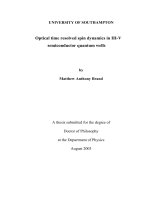optical identification mineral
Bạn đang xem bản rút gọn của tài liệu. Xem và tải ngay bản đầy đủ của tài liệu tại đây (1.31 MB, 28 trang )
Optical Mineralogy in a Nutshell
Use of the petrographic microscope in
three easy lessons
Part III
Slides borrowed/adapted from Jane Selverstone (University of New Mexico) and John W inter (W hitman College)
Some review…
Optical mineral properties ONLY visible in PPL:
Color – not an interference color! (for that, see below)
Pleochroism – is there a color change while rotating stage?
Relief – low, intermediate, high, very high?
Optical mineral properties visible in PPL or XPL:
Cleavage – number and orientation of cleavage planes
(may need higher magnification and at different grains)
Habit – characteristic form of mineral (sometimes better in XPL)
Optical mineral properties ONLY visible in XPL:
Birefringence – use highest order interference color to describe
Twinning – type of twinning, orientation
Extinction angle – parallel or inclined? Angle?
Isotropic vs. anisotropic minerals – 100% extinct in XPL?
Today we’ll break down anisotropic minerals into
uniaxial or biaxial…
Some generalizations and vocabulary
• All isometric minerals (e.g., garnet) and glass are
isotropic – they cannot reorient light. These minerals
are always black in crossed polars.
• All other minerals are anisotropic – they are all
capable of reorienting light.
• All anisotropic minerals contain one or two special
directions (the “optic axes”) that do not reorient light.
– Minerals with one special direction are called uniaxial
– Minerals with two special directions are called biaxial
• Uniaxial and biaxial minerals can be subdivided into
optically positive and optically negative, depending on the
orientation of fast and slow rays relative to the xtl axes
All anisotropic minerals can resolve light into two plane
polarized components that travel at different velocities and
vibrate in planes that are perpendicular to one another
Some light is now
able to pass
through the
upper polarizer
fast ray
slow ray
mineral
grain
plane polarized
light
W
E
lower polarizer
When light gets split:
-velocity changes
-rays get bent (refracted)
-2 new vibration directions
-usually see new colors
Calcite experiment and double refraction
O
E
Fig 6-8 Bloss, Optical
Crystallography, MSA
Fig 6-7 Bloss, Optical
Crystallography, MSA
We’ve talked about minerals as magicians now let’s prove it!
calcite
ca
lc
it
e
ca l
calcite
cit
e
calcite
ordinary
ray, ω
(stays stationary)
extraordinary
ray, ε
(rotates)
How light behaves depends on crystal structure
(there is a reason you took mineralogy!)
Isotropic
Isometric
– All crystallographic axes are equal
Uniaxial
Hexagonal, trigonal, tetragonal
– All axes ⊥ c are equal but c is unique
Biaxial
Orthorhombic, monoclinic, triclinic
– All axes are unequal
Let’s use all of this information to help us identify minerals
Simple guide to interference figures
• Get a good interference figure;
• Distinguish uniaxial and biaxial figures;
• Determine optic sign; and
• Estimate 2V
1) Choose a grain showing the lowest interference colors
2) Move to the high-powered objective lens and refocus
3) Open the sub-stage diaphragm as wide as possible
4) Insert the condenser lens
5) Cross the polars
6) Insert the Bertrand lens
Use of interference figures, continued…
You will see a very small, circular field of view with one or more
black isogyres -- rotate stage and watch isogyre(s)
or
uniaxial
If uniaxial, isogyres define
cross; arms remain N-S/E-W as
stage is rotated
biaxial
If biaxial, isogyres define curve that
rotates with stage, or cross that
breaks up as stage is rotated
Use of interference figures, continued…
Now determine the optic sign of the mineral:
1. Rotate stage until isogyre is concave to NE (if biaxial)
2. Insert gypsum accessory plate
3. Note color in NE, immediately adjacent to isogyre -
Blue = (+)
Yellow = (-)
uniaxial
(+)
(+)
biaxial
Without plate
Gypsum plate inserted
Remember determining optic sign last week with the gypsum plate?
blue in NE = (+)
Gypsum plate has constant ∆ of
530 nm = 1st-order pink
slo
w
Isogyres = black:
∆=0
Background = gray: ∆=100
Add or subtract 530 nm:
530+100=630 nm = blue = (+)
530-100=430 nm = yellowish = (-)
Addition = slow + slow
Subtraction = slow + fast
Time for some new tricks: the optical indicatrix
Thought experiment:
Consider an isotropic mineral (e.g., garnet)
Imagine point source of
light at garnet center;
turn light on for fixed
amount of time, then map
out distance traveled by
light in that time
What geometric shape is defined by mapped light rays?
Isotropic indicatrix
Soccer ball
(or an orange)
Light travels the same
distance in all directions;
n is same everywhere,
thus δ = nhi-nlo = 0 = black
anisotropic minerals - uniaxial indicatrix
c-axis
c-axis
calcite
quartz
Let’s perform the same thought experiment…
Uniaxial indicatrix
c-axis
c-axis
tangerine = uniaxial (-)
Spaghetti squash = uniaxial (+)
quartz
calcite
Uniaxial ellipsoid and conventions:
Fig 6-11 Bloss, Optical
Crystallography, MSA
(-) crystal:
ω>ε
→ oblate
(+) crystal:
ε>ω
→ prolate
Propagate light along the c-axis, note what
happens to it in plane of thin section
nω
χ=Ζ
nω
nε
νω
β=Ψ
α=Ξ
nω - nω = 0
therefore, δ=0: grain stays black
(same as the isotropic case)
Now propagate light perpendicular to c-axis
nε - nω > 0
N
therefore, δ > 0
ω
nnε ε
n ωnω
W
nnω
nω
n
nε
nε
ε
E
S
Grain changes color upon rotation.
Grain will go black whenever indicatrix
axis is E-W or N-S
This orientation will show the maximum δ of the mineral
anisotropic minerals - biaxial indicatrix
clinopyroxene
feldspar
Now things get a lot more complicated…
Biaxial indicatrix
(triaxial ellipsoid)
OA
Z
2Vz
OA
2Vz
νγ
Y
nβ
νβ
να
nβ
The potato!
X
nγ
nγ
να
νβ
nα
νβ
There are 2 different ways to cut this and get a circle…
Alas, the potato (indicatrix) can have any orientation
within a biaxial mineral…
Y c
a
Z
Z
olivine
c
augite
b
Y
b
X
a
X
… but there are a few generalizations that we can make
The potato has 3 perpendicular principal axes of
different length – thus, we need 3 different RIs
to describe a biaxial mineral
X direction = nα (lowest)
Y direction = nβ (intermed; radius of circ. section)
Z direction = nγ (highest)
• Orthorhombic: axes of indicatrix coincide w/ xtl axes
• Monoclinic: Y axis coincides w/ one xtl axis
• Triclinic: none of the indicatrix axes coincide w/ xtl axes
2V: a diagnostic property of biaxial minerals
OA
Z
OA
• When 2V is acute about Z: (+)
2Vz
• When 2V is acute about X: (-)
• When 2V=90°, sign is indeterminate
νγ
• When 2V=0°, mineral is uniaxial
Y
nβ
να
X
2V is measured using an interference figure…
More in a few minutes
How interference figures work (uniaxial example)
Converging lenses force light
rays to follow different paths
through the indicatrix
Bertrand
lens
N-S polarizer
What do we see??
Sample
(looking down OA)
n
ε
substage
condensor
nω
n
nε
ω
nω
nε
n
ε
n
ω
Effects of multiple cuts thru indicatrix
W
E
Biaxial interference figures
There are lots of types of biaxial figures… we’ll concentrate on only two
1. Optic axis figure - pick a grain that stays dark on rotation
Will see one
curved isogyre
determine sign w/ gyps
(+)
determine 2V from curvature of isogyre
90°
60°
40°
See Nesse p. 103
(-)









